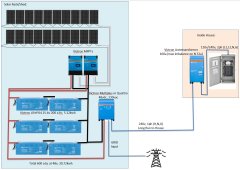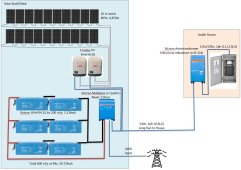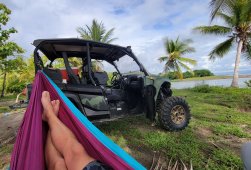l00semarble
New Member
- Joined
- Jan 1, 2022
- Messages
- 150
Hey I'm new here. Hello to the group.
I am building a medium sized 3 bedroom "luxury" home in the jungle in Costa Rica. We have US spec 120/240v split phase power here. I have done a load inventory but it is somewhat hypothetical based on all the appliances and such that I will buy and spec for the home. I do have real data from my current house where we have averaged around 1,000kwh/mo during occupancy.
One of the killer loads in current house is a single speed pool pump that is used 365 days/year. The new house is a bit larger and will have a garage/workshop but we will spec all LED lighting, highest efficiency appliances including the best possible variable speed pool pump and we will spec a rooftop non-electric solar water heater. The new house will have mini-split air conditioners in the 3 bedrooms but they would not be regularly used as the house has an open air design and is at an elevation that makes it unnecessary but they may be used for humidity control if/when we are away from the house or to briefly cool/duhumidify a bedroom bedtime if it had been closed up and stuffy. Cooking can be either electric or I could do a propane stove but I have to hump my own propane bottles if I do this which is not a deal breaker but this is an hassle and an energy cost that I would like to avoid if possible.
I'm still working the spreadsheet but I figured I will need about 900 kwh/mo.
Electricity here is expensive at about $0.15/kw so part of the goal is to reduce energy costs to at/near zero for my retirement but the other problem is that the grid at our remote location is unstable and causes constant problems with appliances. We are constantly replacing "motherboards" and "control boards" and small appliances due to damage from voltage fluctuations and frequent momentary outages.
So we want a system that provides cost savings but also protects us from the unstable grid. Exporting to grid is complicated/bureaucratic here and you don't get the full benefit back of the power you export. I'd rather store it and forget export.
I own a a marine electronics/electrical shop and we are a dealer for VIctron Energy but my Victron experience is limited to marine applications. Because I am very familiar with the products and because I can get Victron at wholesale I plan to spec an all Victron system including batteries.
I am working on sizing of solar array and battery bank but I think I will end up with about (at least) 10kw of solar and at least 30-40 kwh of batteries and that much battery basically only gives 1 day of autonomy but I will use the grid like a backup generator and use the Victron system with their Energy Storage System (ESS) setup to use grid if necessary but always optimize self consumption and maintain zero export. Victron has some very flexible/configurable options for their ESS systems and I believe the inverters can act quickly enough (maybe using UPS mode?) to avoid passing through any voltage flucuations or other grid instability anomalies.
i need to consider what Energy Storage System topography and what Victron equipment is going to make the most sense. I was planning a 48v battery bank as it will be exclusively for the ESS system so seems that would be most efficient. To get split phase I plan to use a 230v inverter and a Victron autotransformer but I will also spec as many of my appliances as 240v as possible to keep the AT balanced as possible. I am thinking this is better than using two inverters to make split phase 120/240v but open to any thoughts on that.
So the main choice regarding overall topography is do I use a AC PV "grid tie" inverter (Fronius) on the output side of the Victron inverter or do I just use Victron MPPT controllers and put all PV into the DC side. With the later I stay virtually all Victron. I guess I can check the cost difference and go based on that but I am wondering about the performance difference or what relative advantages/disadvantages there are. I assume direct consumption off an AC PV inverter is technically more efficient than going through an MPPT and a DC to AC inverter so maybe that is the main difference. I guess I would have more total AC wattage available during daylight so I can also make a point of running certain heavy loads like the pool pump or dryer during daylight.
Thoughts?

OR

I am building a medium sized 3 bedroom "luxury" home in the jungle in Costa Rica. We have US spec 120/240v split phase power here. I have done a load inventory but it is somewhat hypothetical based on all the appliances and such that I will buy and spec for the home. I do have real data from my current house where we have averaged around 1,000kwh/mo during occupancy.
One of the killer loads in current house is a single speed pool pump that is used 365 days/year. The new house is a bit larger and will have a garage/workshop but we will spec all LED lighting, highest efficiency appliances including the best possible variable speed pool pump and we will spec a rooftop non-electric solar water heater. The new house will have mini-split air conditioners in the 3 bedrooms but they would not be regularly used as the house has an open air design and is at an elevation that makes it unnecessary but they may be used for humidity control if/when we are away from the house or to briefly cool/duhumidify a bedroom bedtime if it had been closed up and stuffy. Cooking can be either electric or I could do a propane stove but I have to hump my own propane bottles if I do this which is not a deal breaker but this is an hassle and an energy cost that I would like to avoid if possible.
I'm still working the spreadsheet but I figured I will need about 900 kwh/mo.
Electricity here is expensive at about $0.15/kw so part of the goal is to reduce energy costs to at/near zero for my retirement but the other problem is that the grid at our remote location is unstable and causes constant problems with appliances. We are constantly replacing "motherboards" and "control boards" and small appliances due to damage from voltage fluctuations and frequent momentary outages.
So we want a system that provides cost savings but also protects us from the unstable grid. Exporting to grid is complicated/bureaucratic here and you don't get the full benefit back of the power you export. I'd rather store it and forget export.
I own a a marine electronics/electrical shop and we are a dealer for VIctron Energy but my Victron experience is limited to marine applications. Because I am very familiar with the products and because I can get Victron at wholesale I plan to spec an all Victron system including batteries.
I am working on sizing of solar array and battery bank but I think I will end up with about (at least) 10kw of solar and at least 30-40 kwh of batteries and that much battery basically only gives 1 day of autonomy but I will use the grid like a backup generator and use the Victron system with their Energy Storage System (ESS) setup to use grid if necessary but always optimize self consumption and maintain zero export. Victron has some very flexible/configurable options for their ESS systems and I believe the inverters can act quickly enough (maybe using UPS mode?) to avoid passing through any voltage flucuations or other grid instability anomalies.
i need to consider what Energy Storage System topography and what Victron equipment is going to make the most sense. I was planning a 48v battery bank as it will be exclusively for the ESS system so seems that would be most efficient. To get split phase I plan to use a 230v inverter and a Victron autotransformer but I will also spec as many of my appliances as 240v as possible to keep the AT balanced as possible. I am thinking this is better than using two inverters to make split phase 120/240v but open to any thoughts on that.
So the main choice regarding overall topography is do I use a AC PV "grid tie" inverter (Fronius) on the output side of the Victron inverter or do I just use Victron MPPT controllers and put all PV into the DC side. With the later I stay virtually all Victron. I guess I can check the cost difference and go based on that but I am wondering about the performance difference or what relative advantages/disadvantages there are. I assume direct consumption off an AC PV inverter is technically more efficient than going through an MPPT and a DC to AC inverter so maybe that is the main difference. I guess I would have more total AC wattage available during daylight so I can also make a point of running certain heavy loads like the pool pump or dryer during daylight.
Thoughts?

OR




